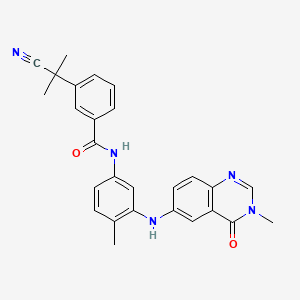Drug Information
Drug (ID: DG01522) and It's Reported Resistant Information
| Name |
AZ628
|
||||
|---|---|---|---|---|---|
| Synonyms |
878739-06-1; AZ 628; AZ-628; AZ628; 3-(2-Cyanopropan-2-yl)-N-(4-methyl-3-((3-methyl-4-oxo-3,4-dihydroquinazolin-6-yl)amino)phenyl)benzamide; AZD628; UNII-560S6B5D79; 3-(2-cyanopropan-2-yl)-N-(4-methyl-3-(3-methyl-4-oxo-3,4-dihydroquinazolin-6-ylamino)phenyl)benzamide; 3-(1-Cyano-1-methylethyl)-N-[3-[(3,4-dihydro-3-methyl-4-oxo-6-quinazolinyl)amino]-4-methylphenyl]benzamide; 3-(Cyano-dimethyl-methyl)-N-[4-methyl-3-(3-methyl-4-oxo-3,4-dihydro-quinazolin-6-ylamino)-phenyl]-benzamide; CHEMBL2144069; 3-(2-cyanopropan-2-yl)-N-[4-methyl-3-[(3-methyl-4-oxoquinazolin-6-yl)amino]phenyl]benzamide; 560S6B5D79; C27H25N5O2; 3-(2-Cyanopropan-2-Yl)-N-{4-Methyl-3-[(3-Methyl-4-Oxo-3,4-Dihydroquinazolin-6-Yl)amino]phenyl}benzamide; B1E; MLS006010314; GTPL8475; SCHEMBL4209241; CHEBI:91354; DTXSID70236677; EX-A302; QCR-186; HMS3265I11; HMS3265I12; HMS3265J11; HMS3265J12; HMS3656F21; HMS3743G19; BCP02117; BDBM50430022; MFCD17392577; NSC782007; s2746; ZINC38226503; AKOS016011304; BCP9000346; CCG-264992; CS-0091; NSC-782007; SB19421; NCGC00250380-01; NCGC00250380-03; NCGC00250380-10; AC-26863; Benzamide, 3-(1-cyano-1-methylethyl)-N-(3-((3,4-dihydro-3-methyl-4-oxo-6-quinazolinyl)amino)-4-methylphenyl)-; BS-42436; HY-11004; SMR004701380; FT-0700393; SW219448-1; Y0332; J-510421; BRD-K05804044-001-01-1; Q27074677; 3-(1-Cyano-1-methylethyl)-N-{4-methyl-3-[(3-methyl-4-oxo-3,4-dihydroquinazolin-6-yl)amino]phenyl}benzamide
Click to Show/Hide
|
||||
| Indication |
In total 1 Indication(s)
|
||||
| Structure |

|
||||
| Target | Platelet-derived growth factor receptor (PDGFR) | NOUNIPROTAC | [1] | ||
| Tyrosine-protein kinase Kit (KIT) | KIT_HUMAN | [1] | |||
| Vascular endothelial growth factor receptor 2 (KDR) | VGFR2_HUMAN | [1] | |||
| Click to Show/Hide the Molecular Information and External Link(s) of This Drug | |||||
| Formula |
5
|
||||
| IsoSMILES |
CC1=C(C=C(C=C1)NC(=O)C2=CC(=CC=C2)C(C)(C)C#N)NC3=CC4=C(C=C3)N=CN(C4=O)C
|
||||
| InChI |
InChI=1S/C27H25N5O2/c1-17-8-9-21(31-25(33)18-6-5-7-19(12-18)27(2,3)15-28)14-24(17)30-20-10-11-23-22(13-20)26(34)32(4)16-29-23/h5-14,16,30H,1-4H3,(H,31,33)
|
||||
| InChIKey |
ZGBGPEDJXCYQPH-UHFFFAOYSA-N
|
||||
| PubChem CID | |||||
| ChEBI ID | |||||
| TTD Drug ID | |||||
Type(s) of Resistant Mechanism of This Drug
Drug Resistance Data Categorized by Their Corresponding Diseases
ICD-02: Benign/in-situ/malignant neoplasm
| Drug Sensitivity Data Categorized by Their Corresponding Mechanisms | ||||
|
|
||||
| Key Molecule: Serine/threonine-protein kinase B-raf (BRAF) | [1] | |||
| Molecule Alteration | Missense mutation | p.G466E (c.1397G>A) |
||
| Sensitive Disease | Melanoma [ICD-11: 2C30.0] | |||
| Experimental Note | Identified from the Human Clinical Data | |||
| In Vitro Model | SW1736 cells | Thyroid | Homo sapiens (Human) | CVCL_3883 |
| 8505C cells | Thyroid | Homo sapiens (Human) | CVCL_1054 | |
| Hth104 cells | Thyroid gland | Homo sapiens (Human) | CVCL_A427 | |
| In Vivo Model | mouse xenograft model | Mus musculus | ||
| Mechanism Description | The missense mutation p.G466E (c.1397G>A) in gene BRAF cause the sensitivity of AZ628 by aberration of the drug's therapeutic target | |||
| Key Molecule: Serine/threonine-protein kinase B-raf (BRAF) | [1] | |||
| Molecule Alteration | Missense mutation | p.V600R (c.1798_1799delGTinsAG) |
||
| Sensitive Disease | Melanoma [ICD-11: 2C30.0] | |||
| Experimental Note | Identified from the Human Clinical Data | |||
| In Vitro Model | SW1736 cells | Thyroid | Homo sapiens (Human) | CVCL_3883 |
| 8505C cells | Thyroid | Homo sapiens (Human) | CVCL_1054 | |
| Hth104 cells | Thyroid gland | Homo sapiens (Human) | CVCL_A427 | |
| In Vivo Model | mouse xenograft model | Mus musculus | ||
| Mechanism Description | The missense mutation p.V600R (c.1798_1799delGTinsAG) in gene BRAF cause the sensitivity of AZ628 by aberration of the drug's therapeutic target | |||
| Key Molecule: Serine/threonine-protein kinase B-raf (BRAF) | [1] | |||
| Molecule Alteration | Missense mutation | p.V600E (c.1799T>A) |
||
| Sensitive Disease | Melanoma [ICD-11: 2C30.0] | |||
| Experimental Note | Identified from the Human Clinical Data | |||
| In Vitro Model | SW1736 cells | Thyroid | Homo sapiens (Human) | CVCL_3883 |
| 8505C cells | Thyroid | Homo sapiens (Human) | CVCL_1054 | |
| Hth104 cells | Thyroid gland | Homo sapiens (Human) | CVCL_A427 | |
| In Vivo Model | mouse xenograft model | Mus musculus | ||
| Mechanism Description | The missense mutation p.V600E (c.1799T>A) in gene BRAF cause the sensitivity of AZ628 by aberration of the drug's therapeutic target | |||
| Key Molecule: Serine/threonine-protein kinase B-raf (BRAF) | [1] | |||
| Molecule Alteration | Missense mutation | p.V600D (c.1799_1800delTGinsAC) |
||
| Sensitive Disease | Melanoma [ICD-11: 2C30.0] | |||
| Experimental Note | Identified from the Human Clinical Data | |||
| In Vitro Model | SW1736 cells | Thyroid | Homo sapiens (Human) | CVCL_3883 |
| 8505C cells | Thyroid | Homo sapiens (Human) | CVCL_1054 | |
| Hth104 cells | Thyroid gland | Homo sapiens (Human) | CVCL_A427 | |
| In Vivo Model | mouse xenograft model | Mus musculus | ||
| Mechanism Description | The missense mutation p.V600D (c.1799_1800delTGinsAC) in gene BRAF cause the sensitivity of AZ628 by aberration of the drug's therapeutic target | |||
References
If you find any error in data or bug in web service, please kindly report it to Dr. Sun and Dr. Zhang.
